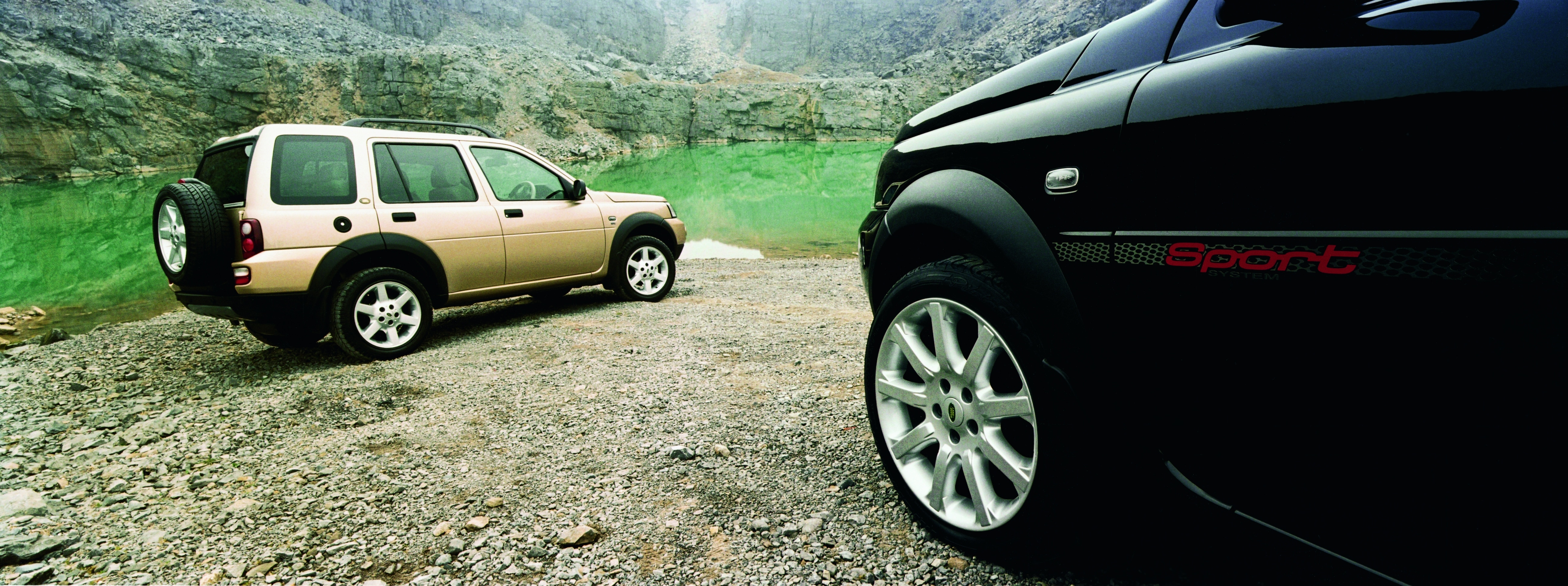The Land Rover Freelander…

[vc_row][vc_column][vc_column_text]We’ve teased you with the notion of getting dirty with the Subaru Forester. With four-wheel drive and a lifted chassis, it can go off the beaten track. But, as we said in the review, it can’t go too far from it. What if you want to scale a mountain, or drive over a goat, or, we don’t know, park in a river? What do you buy? Don’t worry, dear reader, we’ve got your back. That’s why this post is all about the rather ace Land Rover Freelander. A car that, we feel, gained a bit of an unfair reputation for being a bit soft, or ‘not proper’ enough. Ignore the haters. The Freelander is a top bit of kit.[/vc_column_text][/vc_column][/vc_row][vc_row][vc_column][vc_single_image image=”2474″ img_size=”full” onclick=”img_link_large” css_animation=”appear”][/vc_column][/vc_row][vc_row][vc_column][vc_column_text]Launched in 1997, the Land Rover Freelander was aimed at the ‘lifestyle’ market, and for saying that, we feel dirty. Sorry. But hey, that’s the truth. In the late ’90s we were buying cars of this ilk to make a statement, rather than to actually drive up a mountain. As such, the Rav 4, the Vitara and others were selling well. Land Rover, being the daddy of fun with four-wheel drive, rightly wanted a slice of the action. Why the hell should Toyota get all the sales?
So, in response to the market trend, Land Rover gave us the Freelander. And it was good. But at the same time, it was bad. Which, once we’ve shown you a Freelander being a filthy minx, we’ll explain.[/vc_column_text][/vc_column][/vc_row][vc_row][vc_column][vc_single_image image=”2480″ img_size=”full” onclick=”img_link_large” css_animation=”appear”][/vc_column][/vc_row][vc_row][vc_column][vc_column_text]We’ll start with the good. And it was good. Okay, so some of the early ones were screwed together by people far more concerned with their tea breaks than your disc brakes, but once that was ironed out, the Freelander was great. It was easy on the eye – funky almost – so the ‘lifestyle’ set would like it. You could have it without a roof, perfect for driving down Oxford Street on a warm, sunny evening. Or, you know, where most 4x4s end up. Oh, and it also had some good engines. Well, we’ll ignore the 1.8 four-cylinder petrol, but the Td4 BMW 2.0 diesel and Rover 2.0 diesel were good lumps. There was also a 2.5 V6 petrol. Spritely engine, but man alive was it thirsty. Only buy one if you work from home.
It drove well, too. Despite being tall, the Freelander didn’t wallow about like a fat kid on the teacups. In fact, it was relatively composed given its height. As such, it was the kind of car that could be driven every day without compromise. A good selling point there. And that BMW Td4 lump was frugal, too. Low-40s were within the realms of average economy.[/vc_column_text][/vc_column][/vc_row][vc_row][vc_column][vc_single_image image=”2471″ img_size=”full” onclick=”img_link_large” css_animation=”appear”][/vc_column][/vc_row][vc_row][vc_column][vc_column_text]Inside was also good. The Freelander’s innards were rugged and chunky, like a Tonka toy. Okay, so some of the buttons were in odd places, but increased familiarity would soon sort that. It was the sort of interior that was comfy, but still looked like it could shave the rough bits off a lump of wood. Proper 4×4 clobber, basically. Chunky. In a good way. Unless you got one with leather of course, like the ‘up-scale farmer who now uses their land for glamping’ type.
So yeah, all in all the Freelander was, and still is, a good bit of kit. But before we send you scampering off to the classifieds, we need to tell you about the negatives. Of which there are a few, sadly.[/vc_column_text][/vc_column][/vc_row][vc_row][vc_column][vc_single_image image=”2475″ img_size=”full” onclick=”img_link_large” css_animation=”appear”][/vc_column][/vc_row][vc_row][vc_column][vc_column_text]The main thing to plague the Freelander, or at least the ones we’re looking at (we’re choosing to ignore anything pre-2000) is rust. Man, do these suckers like to rot from underneath you. Much like the Discovery that went alongside it, the Freelander was a magnet for metal oxidisation. That’s not good on any car, let a alone one that can drive through a canal. So look out for that.
There’s also the issue of reliability. This is a British vehicle after all, so it was screwed together with hope as much as actual screws. The early ones were terribly built, but by 2000 they had mostly ironed out all the kinks/worked out a mutually satisfactory deal with the unions. But still, you want be thorough. Just because you’re dropping two grand, not twenty, it doesn’t mean you can’t have a good rifle through the paperwork. You don’t need to buy a snotter.[/vc_column_text][/vc_column][/vc_row][vc_row][vc_column][vc_single_image image=”2467″ img_size=”full” onclick=”img_link_large” css_animation=”appear”][/vc_column][/vc_row][vc_row][vc_column][vc_column_text]That’s the bad stuff dealt with. Let’s go back to the positive, namely the Freelander’s ability to get muddy. Yes, this is smaller than a Discovery. Yes, it was built to suit the market of people called Sebastian who live in city-centre maisonettes, but damn if it wasn’t good off-road anyway. It is, after all, what Land Rover does. There was no way the Freelander was going to slip under the net. As such, you got front-biased full-time four-wheel drive. That’s a lot hyphens. What you didn’t get was a low ratio ‘box. You might argue that its absence means the Freelander was not a proper 4×4. We say shush you face. It’s absence is in fact its brilliance.
Anybody can take the Freelander anywhere. Always wanted to go off-roading, but never taken the plunge? The Freelander is for you. It does all the ‘thinking’ on your behalf. All you have to do is pick a gear (and hopefully common sense will help you on that front) and do the pedals. The Freelander does the rest. And if you’re worried about tumbling down a hill, don’t be. The Freelander came with hill-descent control as standard on all but the most basic of models. To the layman, that means you won’t be seen hurtling down a muddy one-in-three hill at 76mph.[/vc_column_text][/vc_column][/vc_row][vc_row][vc_column][vc_single_image image=”2485″ img_size=”full” onclick=”img_link_large” css_animation=”appear”][/vc_column][/vc_row][vc_row][vc_column][vc_column_text]As you can probably tell, we’re quite fond of the Freelander. It’s got a certain rugged charm that other cars in its class lack. That comes from it being an actual real life Land Rover, not a poor facsimile. Yes, you can get a Discovery for this money, and the Disco is good. But by comparison, quid for quid, the Discos are all battered, or rusty, or have more miles than the Exxon Valdez. And they probably leak more oil.
A Freelander, however, can be bought for £2,000 in reasonable shape, without galactic miles and with a ready and waiting attitude toward exploring the unexplored. Go on, buy one.[/vc_column_text][/vc_column][/vc_row]






